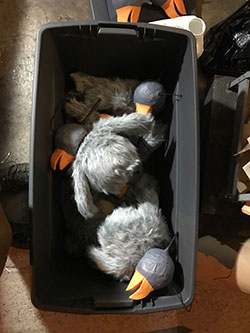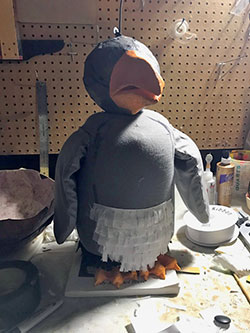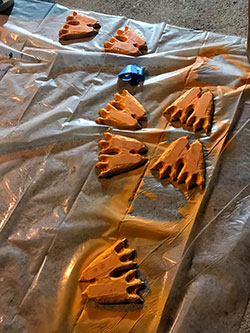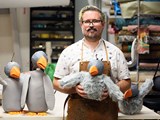By Tania Thompson
Twenty-Four Puppets for "Mr. Popper’s Penguins"



The puppets in Mr. Popper’s Penguins—two-dozen of them—come from the creative mind of designer Sean T. Cawelti, who was first drawn to the art form as a child. He now is one of the country’s leading large-form puppet designers.
As a three-year-old, Cawelti and his parents visited a swap meet where he was drawn to an old Mexican marionette.
“I fixated on that and it became the only thing I played with,” he recalls. “As a kid, I would create puppet theatre using him.” Cawelti’s father built a puppet-sized stage and his mother did the sewing, a skill she taught to her son.
Through junior high and high school, he pursued work with puppets and technology and the use of larger puppets. In high school, the drama teacher mentored him, although she had no puppetry background, and helped him bring to life his own adaptation of Alice in Wonderland with 20 puppets.
Through a professor’s encouragement at the University of California, Irvine, and an intensive puppetry program at New York University, Cawelti’s creative theatre path was locked in.
In Mr. Popper’s Penguins, Mr. and Mrs. Popper’s lives take an adventurous turn when a mysterious box arrives on their doorstep with a penguin inside. Not long after, the local aquarium sends over a female penguin and soon, the Poppers are hearing the patter of 20 little feet (that’s 10 baby penguins, if you’re counting).
Cawelti started his penguin research online, looking at videos and photos of penguins, as well as caricatures, drawings and other puppet penguins. He was most surprised to find that penguins actually have longer legs, but most of the images show them pushing their legs together with just part of their feet showing.
He also learned that baby penguins are gray, have feathers (which are not yet black and white) and cannot swim; the distinctive tuxedo look comes with adulthood, with white and black enabling them to blend in with snow or cold, dark water to protect them from predators.
“But at some point, I banish the research and then just start the creative process to pull what’s in my ‘noggin’ and then the style and form are born,” he says. “Of course, I have taken liberties with my designs, to give the penguins a bigger sense of character to fit the story.”
For the play, Cawelti has designed 24 puppets—two adult penguins (Captain Cook and Greta), 10 baby penguins and 10 adolescent penguins, along with a villainous seal. Each puppet takes between 20 and 80 hours to build.
While he didn’t want to anthropomorphize the puppets, Cook’s facial expression is of woe and heaviness, while Greta is more bright and cheery.
He designed the baby penguins as “puffballs” and four different adolescent body designs have 10 different heads, with varying expressions.
To help with the puppet structure, Cawelti built the frames from foam and then cut and glued them into different shapes. Spines are made from lightweight plastic and ball-and-socket joints are made from molded PVC piping, with a center bungie cord to allow movement. He found the neck joints to be the most challenging and redesigned them once rehearsals began. Jersey t-shirt material and silk ribbons are the exterior fabrics, with texturing that alludes to feathers.
Finally, during the rehearsal process, Cawelti trains the cast as an ensemble in puppeteering so that all six actors have a common vocabulary to work from with the puppets.
“I hope through all this work—the designs, the cast and the creative team—that audiences will be inspired to learn more about penguins and also about our world in general, since the play takes us all over the world,” he says.


